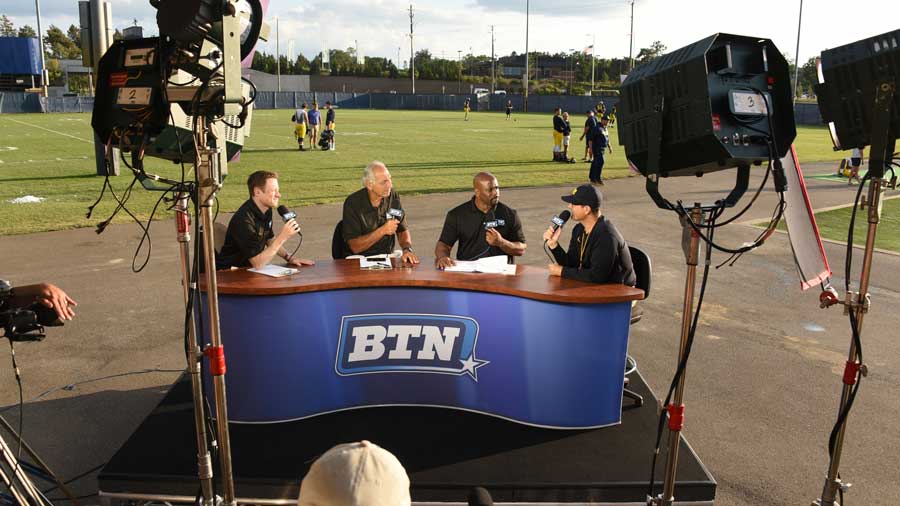For BTN, It’s Been a Big Ten Years

Outside his office, Big Ten Network president Mark Silverman still has the giant switch he pulled at a launch party in a Chicago restaurant 10 years ago this week to light up the sports channel.
A joint venture between Fox Networks Group and the Big Ten Conference, BTN, as it’s now known, has been a pioneer, one of the first sports networks dedicated to a specific league or conference. And it continues to use an innovative playbook to stay ahead of changes in the TV business.
In addition to its linear network, BTN offers programming on digital and social platforms including the kind of direct-to consumer subscription-only product that sports giant ESPN is making news for planning to launch. It’s also becoming a sports studio, creating programming for other networks, and has hosted an eSports tournament.
“Because we’re this separate company, we’ve really been able to try new things, to experiment and to be early adopters,” Silverman said.
But when it started, just getting cable coverage in the markets where the Big Ten’s then-11 schools were located was a challenge. The channel launched on DirecTV, then added Dish Network, but for its first year it wasn’t on any of the major MSOs.
BTN decided to produce all of its games in HD at a time when other networks were still making the transition. “There was a perception early on that we looked good,” Silverman said.
A deal was struck with Comcast before the start of year two, and the other big cable operators followed.
Broadcasting & Cable Newsletter
The smarter way to stay on top of broadcasting and cable industry. Sign up below
Flash forward to this year, and the Big Ten has 14 schools including Rutgers in the New York market and Maryland in the Washington-Baltimore area. It is in about 60 million homes, including a presence in California, Arizona and Texas, where the conference doesn’t have members.
BTN’s revenue is expected to rise 8% to $401.1 million this year, according to research company Kagan. Cash flow is forecast at $159.4 million, up 10%.
With a base of viewers that includes cord-never college students and recent grads, Silverman notes that somehow, the network is still being watched. More BTN content is viewed online than on-air.
“You have to recognize that people are watching television differently and then do the best we can to increase our overall viewership and to grow our business in a variety of ways,” Silverman said.
In 2011, the network was one of the first to launch a TV Everywhere app, BTN 2 Go, making its programming available on mobile devices to authenticated subscribers.
And in 2014, it launched BTN Plus, which for about $10 per month makes another 1,100 events available. BTN Plus counts 30,000 subscribers, Silverman said.
BTN is on all the major virtual multichannel video programming distributors except for Sling TV.
“Some of the students, they may subscribe through DirecTV Now or through Hulu and that’s how they’re getting the games. Or they could be sharing their parents’ password,” Silverman said.
Last year, Fox agreed to pay $240 million for additional Big Ten rights, including first pick among each week’s football games.
Silverman said this season BTN will be working more closely with Fox in promotion and production and sharing talent. “It is a fantastic opportunity for BTN and Fox to work together to create more content and more of a roadmap for Big Ten fans to know where to go.”
BTN will also sport more Fox-like graphics during games and is eyeing “a complete refresh, taking the next step forward as we evolve our brand,” Silverman said.
New Studio Side
BTN is also moving into the studio business, creating additional content, including programming, that can appear on other networks. Already it is producing a program for Fox Sports Ohio and a deal for a show that will air on a couple of other networks is in the works. “That is going to be a major growth area for us over the next three to five years,” Silverman said.
BTN this season is also putting staffers on four of the conference’s campuses to create daily content that can be distributed via BTN 2 Go and other digital and social platforms.
Silverman said he urges his staff to be innovative. The message: “Get on the train and then find your seat, as opposed to missing the train.”
“Make no mistake about it, the most important thing we do is produce our games and televise the games with our major affiliate partners, but as time progresses these games are available on mobile, they’re available on [over-the-top] providers and the audience continues to grow in the aggregate as you look at viewing across all these different platforms.”
Jon has been business editor of Broadcasting+Cable since 2010. He focuses on revenue-generating activities, including advertising and distribution, as well as executive intrigue and merger and acquisition activity. Just about any story is fair game, if a dollar sign can make its way into the article. Before B+C, Jon covered the industry for TVWeek, Cable World, Electronic Media, Advertising Age and The New York Post. A native New Yorker, Jon is hiding in plain sight in the suburbs of Chicago.

